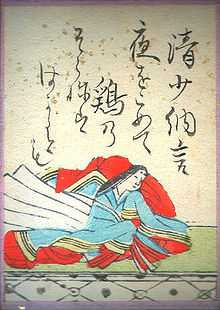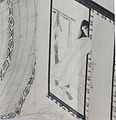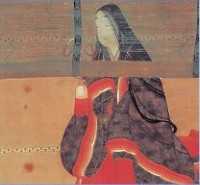Sei Shōnagon
| Sei Shōnagon 清少納言 | |
|---|---|
 Sei Shōnagon, illustration from an issue of Hyakunin Isshu (Edo period) | |
| Born |
Kiyohara Nagiko (清原 諾子) c. 966 |
| Died | 1017 or 1025 |
| Occupation | Lady-in-waiting to Empress Teishi |
| Nationality | Japanese |
| Period | Heian period |
| Notable works | The Pillow Book |
| Spouse |
Tachibana no Norimitsu |
| Children |
Norinaga (son) |
| Relatives |
Kiyohara no Motosuke (father) |
Sei Shōnagon (清少納言, lesser councilor of state Sei), (c. 966–1017/1025) was a Japanese author and a court lady who served the Empress Teishi (Sadako) around the year 1000 during the middle Heian period. She is best known as the author of The Pillow Book (枕草子 makura no sōshi).
Name
Sei Shōnagon's actual given name is not known. It was the custom among aristocrats in those days to call a court lady (女房 nyōbō) by a nickname taken from her clan name or a court office belonging either a close male relative. Sei (清) derives from her father's family name "Kiyohara" (清原) (the native Japanese reading of 清 is kiyo, while the Chinese reading is sei), while Shōnagon (少納言, lesser councilor of state) refers to a government post. It is unknown which of her relatives held the post of shōnagon. However, she was called "Shōnagon" ("minor counselor") at court. Her actual name has been a topic of debate among scholars, who generally favor Kiyohara Nagiko (清原 諾子) as a likely possibility.
Early life
Little is known about her life except what can be found in her writing. She was the daughter of Kiyohara no Motosuke, a scholar and well-known waka poet, who worked as a provincial official. Her grandfather Kiyohara no Fukayabu was also a waka poet. The family were middle-ranking courtiers and had financial difficulties, possibly because they were not granted a revenue-producing office.
She married Tachibana no Norimitsu, a government official at 16, and gave birth to a son, Norinaga. In 993, at 27, when she began to serve the Empress Teishi, consort of Emperor Ichijō, she may have been divorced. When her court service ended she may have married Fujiwara no Muneyo, governor of Settsu province, and had a daughter, Koma no Myobu, although some evidence suggests she became a Buddhist nun.[1]
Writing
Shōnagon became popular through her work The Pillow Book, a collection of lists, gossip, poetry, observations, complaints written during her years in the court, a miscellaneous genre of writing known as zuihitsu. The Pillow Book was circulated at court, and for several hundred years existed in handwritten manuscripts. First printed in the 17th century, it exists in different versions: the order of entries may have been changed by scribes with comments and passages added, edited, or deleted. In The Pillow Book, Shōnagon writes about Empress Teishi, and her disappointment after her father's death when Fujiwara no Michinaga made his daughter Shōshi consort to Ichijō, and then empress, making Teishi one of two empresses at court.
Because of the risk of fire, the Imperial family did not live in the Heian Palace. Empress Teishi resided in a part of Chūgushiki, the Bureau of Serving the (Middle) Empress. Shōnagon writes with apparent lightheartedness about Teishi's death, from childbirth in 1000. According to the prevalent fashion, to have written more passionately would have been considered unstylish. Her writing is considered witty, depicting Teishi's elegant court from a detailed, gossipy perspective.[1]
The entries in The Pillow Book on rhetoric include advice and opinions on conversation, preaching, and letter writing. On conversation, Shōnagon advocates pure language and rigorous use of amenities in the sections of advice, but also offers vignettes showing witty repartee and sociable give-and-take among the empress's ladies and between ladies and gentlemen. Shōnagon also touches upon the topic of preaching. She says that priests should be handsome who are well trained in elocution, with excellent memories, as well as attentive, polite audiences who do not come to services to flirt and show off. Later, she offers detailed information on letter writing, offering prescriptions for paper, calligraphy, accompanying gift and bearer, and appreciation for the value of letters as gifts of love. In particular, Shōnagon paid special attention to "morning-after letters." In Japanese court society, heterosexual sex between courtiers was illicit but happened very often. A social requirement was that the male send a poem on beautiful paper with a decorative flower or branch to the lady, and that she reply. Shōnagon goes in depth about this subject matter in her section called, "Things That Make One Nervous."[1]
Later years
There are no details about Shōnagon's life after the year 1017, and very few records of her after the death of the Empress Teishi/Empress Sadako in 1000. According to one tradition, she lived out her twilight years in poverty as a Buddhist nun. Another tradition has her marrying Fujiwara no Muneyo, the governor of Settsu province, after her court services ended, and having a daughter, Koma no Myobu. The Pillow Book is thought to have been finished sometime between 1001 and 1010, while Shōnagon was in retirement.
Rival
Shōnagon is also known for her rivalry with her contemporary, writer and court lady Murasaki Shikibu, author of The Tale of Genji who served the Empress Shoshi, second consort of the Emperor Ichijō. Murasaki Shikibu wrote about Shōnagon - somewhat scathingly, though conceding Shōnagon's literary gifts - in her diary, The Murasaki Shikibu Diary.
Gallery
-

Sei Shōnagon in a later 13th century drawing
-

Sei Shōnagon in a later 17th century drawing
-

Sei Shōnagon, drawing by Kikuchi Yosai (1788–1878)
Notes and sources
- ↑ 1.0 1.1 1.2 Donawerth, Jane (2002). Rhetorical Theory by Women Before 1900. Lanham, Maryland: Rowman & Littlefield. pp. 22–3. ISBN 978-0-7425-1716-5.
External links
![]() Media related to Sei Shōnagon at Wikimedia Commons
Media related to Sei Shōnagon at Wikimedia Commons
- Britannica | Sei Shonagon
- The Lists of a Lady-in-Waiting. A Portrait of the Author of The Pillow Book.
|